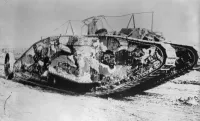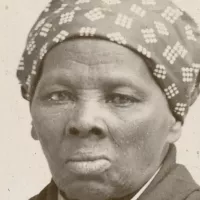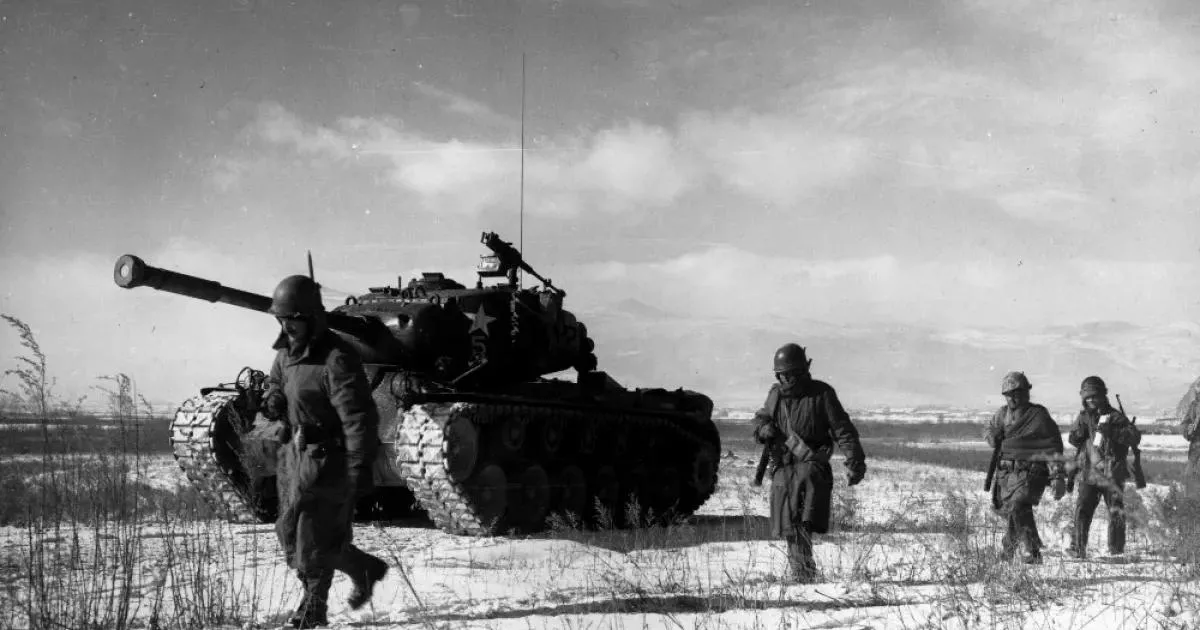The Korean War (1950-1953) was a conflict between North Korea, supported by China and the Soviet Union, and South Korea, supported by the United Nations Command (primarily the United States). It was a major proxy war during the Cold War. The war began when North Korea invaded South Korea, aiming to unify the peninsula under communist rule. The United Nations intervened to defend South Korea. After years of intense fighting and stalemate, the war ended with an armistice in 1953, leaving the Korean Peninsula divided along the Korean Demilitarized Zone. A peace treaty was never signed, so technically, the conflict is ongoing.
1919: Founding of the Provisional Government of the Republic of Korea
In 1919, the Provisional Government of the Republic of Korea was founded in Nationalist China. However, it failed to achieve international recognition, unite nationalist groups, and had a fractious relationship with its US-based founding president, Syngman Rhee.
1941: Korean nationalists fight in the Burma Campaign
From 1941 to 1945, Nationalist-backed Koreans, led by Yi Pom-Sok, fought in the Burma campaign.
1943: Tehran Conference
In 1943, at the Tehran Conference, the Soviet Union promised to join its allies in the Pacific War within three months of the victory in Europe.
February 1945: Soviet promise to join Pacific War
In February 1945, at the Yalta Conference, the Soviet Union promised to join its allies in the Pacific War within three months of the victory in Europe.
September 1945: US military control established in South Korea
In September 1945, General Douglas MacArthur issued Proclamation No. 1, announcing US military control over Korea south of the 38th parallel and establishing English as the official language during military control. US Lieutenant General John R. Hodge arrived in Incheon on 8 September to accept the Japanese surrender south of the 38th parallel and became the military governor.
December 1945: US-Soviet Union Joint Commission established and unrest in Korea
In December 1945, Korea was administered by a US–Soviet Union Joint Commission, as agreed at the Moscow Conference, to grant independence after a five-year trusteeship. Riots broke out due to the unpopularity of waiting five years for independence. To contain them, the USAMGIK banned strikes on 8 December and outlawed the PRK Revolutionary Government and People's Committees on 12 December. Following further civilian unrest, the USAMGIK declared martial law.
1945: Division of Korea after WWII
In 1945, at the end of World War II, Korea was divided into two occupation zones by the Soviet Union and the United States at the 38th parallel, with plans for a future independent state.
April 1948: Socialist uprising begins on Jeju Island
Beginning in April 1948 on Jeju Island, a socialist uprising saw arrests and repression by the South Korean government in the fight against the South Korean Labor Party. This resulted in 30,000 violent deaths, including 14,373 civilians.
May 1948: Both Jeju Island and Yeosu-Suncheon rebellions were crushed
By May 1948, both the Jeju Island and Yeosu–Suncheon rebellions had been crushed by the South Korean government.
August 1948: Establishment of the Republic of Korea
On 15 August 1948, the Republic of Korea (South Korea) was established.
1948: North Korea-backed insurgency breaks out in South
By 1948, a North Korea-backed insurgency had broken out in the southern half of the Korean peninsula. This was worsened by the undeclared border war between the Koreas, resulting in thousands of deaths on both sides. The ROKA was trained and focused on counterinsurgency.
1948: Formation of separate Korean governments
In 1948, due to political disagreements, two separate governments were formed in Korea: North Korea led by Kim Il Sung in Pyongyang, and South Korea led by Syngman Rhee in Seoul. Both claimed legitimacy over all of Korea, leading to border clashes and internal unrest.
1948: Establishment of communist government in North Korea and Soviet withdrawal
In 1948, in the Soviet-Korean Zone of Occupation, the Soviets agreed to the establishment of a communist government led by Kim Il Sung. The 1948 North Korean parliamentary elections took place in August and the Soviet Union withdrew its forces.
March 1949: Kim Il Sung seeks Stalin's support for invasion
In March 1949, Kim Il Sung began seeking Stalin's support for a North Korean invasion of South Korea, believing widespread uprisings had weakened the South Korean military.
May 1949: Battalion-sized battles along the border
Starting in May 1949, the ROKA and KPA engaged in battalion-sized battles along the border.
August 1949: North Korean attack repulsed by South Korean troops
On 4 August 1949, thousands of North Korean troops attacked South Korean troops occupying territory north of the 38th parallel. The 2nd and 18th ROK Infantry Regiments repulsed attacks in Kuksa-bong, and KPA troops were "completely routed".
October 1949: ROKA launches assault on insurgents
On 1 October 1949, the ROKA launched a three-pronged assault on the insurgents in South Cholla and Taegu.
1949: First Official Census in North Korea
According to the first official census in 1949, the population of North Korea numbered 9,620,000.
1949: PLA Divisions Enter North Korea
In the fall of 1949, two PLA divisions composed mainly of Korean-Chinese troops (the 164th and 166th) entered North Korea, followed by smaller units throughout the rest of 1949.
1949: Insurgency reignites in South Korea
In the spring of 1949, insurgency reignited with increased guerrilla attacks in mountainous regions, supported by army defectors and North Korean agents. Insurgent activity peaked in late 1949 as the ROKA engaged People's Guerrilla Units, culminating in a failed offensive in September aimed at undermining the South Korean government.
1949: Soviets Arm North Korea
Throughout 1949, the Soviets continued arming North Korea. After the communist victory in the Chinese Civil War, ethnic Korean units in the PLA were sent to North Korea.
January 1950: Soviet Union Boycotts UN Security Council Meetings
Since January 1950, the Soviet Union had boycotted United Nations Security Council meetings, protesting Taiwan's occupation of China's permanent seat, which left the door open for the UN to condemn North Korea's invasion in June 1950.
March 1950: ROKA claims success in counterinsurgency efforts
By March 1950, the ROKA claimed 5,621 guerrillas killed or captured and 1,066 small arms seized. Soon after, North Korea made final attempts to keep the uprising active. By the spring of 1950, guerrilla activity had mostly subsided.
April 1950: Stalin Permits Kim to Attack South Korea
In April 1950, Stalin gave Kim Il-sung permission to attack South Korea, but with the condition that Mao Zedong would provide reinforcements if needed. Stalin also clarified that Soviet forces would not engage in open combat, to avoid direct conflict with the United States.
May 1950: Kim Meets With Mao to Discuss Korean War Plans
In May 1950, Kim Il-sung met with Mao Zedong to discuss his plans for the Korean War. Some historical interpretations suggest that Mao agreed to support Kim, motivated by the need for economic and military aid from the Soviets. Other sources suggest that Mao cautioned Kim about potential US intervention, but ultimately accepted the decision to unify Korea.
June 1950: South Korean Military Unpreparedness
As of 25 June 1950, the South Korean army (ROK) had 98,000 soldiers with no tanks and a limited air force of 22 planes. Large U.S. garrisons and air forces were in Japan, but only a small number of U.S. troops were in Korea, indicating the ROK's lack of preparedness.
June 1950: Troop Deployment
From June 1950 to July 1953, some 1,789,000 American soldiers served in the war, accounting for 31% of the 5,720,000 Americans who served on active duty worldwide.
June 1950: Start of the Korean War
In June 1950, the Korean War began as an armed conflict between North Korea and South Korea, along with their respective allies. North Korea was supported by China and the Soviet Union, while South Korea was supported by the United Nations Command led by the United States.
June 1950: North Korea invades South Korea
On 25 June 1950, the KPA crossed the 38th parallel behind artillery fire. It justified its assault with the claim ROK troops attacked first. Fighting began on the strategic Ongjin Peninsula in the west.
June 1950: UN Security Council Condemns North Korean Invasion
On 25 June 1950, the United Nations Security Council unanimously condemned the North Korean invasion of South Korea with Resolution 82. On 27 June 1950, the Security Council published Resolution 83 recommending member states provide military assistance to the Republic of Korea, and President Truman ordered U.S. air and sea forces to help.
June 1950: Kim Calls for Korea-Wide Election and Sends Diplomats to the South
On 7 June 1950, Kim Il-sung called for a Korea-wide election to be held on 5–8 August and a consultative conference in Haeju on 15–17 June. On 11 June, the North sent three diplomats to the South as a peace overture, but it was rejected by Rhee. On 21 June, Kim revised his war plan to a general attack across the 38th parallel, rather than a limited operation.
June 1950: Truman Orders Plans for Attacking Soviet Forces
On June 25, 1950, during President Truman's first meeting to discuss the Korean War, he ordered plans to be prepared for attacking Soviet forces should they enter the conflict.
June 1950: KPA Casualties Since End of June 1950
The KPA had suffered some 200,000 soldiers killed or wounded since end of June 1950, for a total of 335,000 casualties.
July 1950: Skirmish between North Korea and the UN Command
On 2 July 1950, a skirmish between North Korea and the UN Command occurred; the U.S. Navy cruiser USS Juneau, the Royal Navy cruiser HMS Jamaica and the Royal Navy frigate HMS Black Swan fought four North Korean torpedo boats and two mortar gunboats, and sank them. USS Juneau later sank several ammunition ships that had been present.
July 1950: Battle of Osan: First Significant US Engagement
On 5 July 1950, Task Force Smith, a small US element, attacked the KPA at Osan but was defeated due to a lack of weapons capable of destroying KPA tanks, resulting in 180 American casualties. The KPA continued progressing southwards.
August 1950: KPAF Reduced to 20 Planes
By early August 1950, the Korean People's Air Force (KPAF) was reduced to only about 20 planes due to jets such as the P-80 Shooting Star, F9F Panther, Gloster Meteor, and other jets under the UN flag dominating the Korean People's Air Force (KPAF) propeller-driven Soviet Yakovlev Yak-9 and Lavochkin La-9s.
August 1950: Kim Calls for Korea-Wide Election
In August 1950, Kim Il-sung had called for a Korea-wide election on 5–8 August, intending to legitimize the North's control over the entire peninsula.
August 1950: Congress Approves Funding for Military Action
In August 1950, Truman and Acheson obtained the consent of Congress to appropriate $12 billion for military action.
August 1950: UN forces brought heavier equipment
The tide turned in favor of the UN forces in August 1950 when the KPA suffered major tank losses during a series of battles in which the UN forces brought heavier equipment to bear, including American M4A3 Sherman and M26 medium tanks, alongside British Centurion, Churchill and Cromwell tanks.
September 1950: UN Forces Outnumber KPA in Pusan Perimeter
In early September 1950, UN forces outnumbered the KPA 180,000 to 100,000 soldiers in the Pusan Perimeter, bolstered by reinforcements and military supplies.
October 1950: High combat casualties for US army
American medical records show that from July to October 1950, the army sustained 31% of the combat deaths it ultimately incurred in the entire 37-month war.
October 1950: China Warns the US About Intervention
On 3 October 1950, China attempted to warn the US, through its embassy in India, it would intervene if UN forces crossed the Yalu River. The US did not respond.
October 1950: Chinese Intervention
The Chinese intervention in late October 1950 bolstered the KPAF with the MiG-15, one of the world's most advanced jet fighters.
November 1950: KPA Armor Rarely Encountered
After November 1950, KPA armor was rarely encountered due to the Incheon landings on 15 September cutting off the KPA supply lines, causing their armored forces and infantry to run out of fuel, ammunition, and other supplies. By the time the KPA withdrew from the South, 239 T-34s and 74 SU-76 self-propelled guns were lost.
November 1950: Chinese Forces Launch First Phase Offensive
After secretly crossing the Yalu River on 19 October, the PVA 13th Army Group launched the First Phase Offensive on 25 October. On 1 November 1950, the first confrontation between Chinese and US military occurred in the Battle of Unsan.
November 1950: Orders for retaliatory atomic bombing
On 5 November 1950, the U.S. Joint Chiefs of Staff issued orders for the retaliatory atomic bombing of Manchurian PRC military bases, if either of their armies crossed into Korea or if PRC or KPA bombers attacked Korea from there.
November 1950: Truman Considers Using Nuclear Weapons
On November 30, 1950, during a press conference, President Truman stated that the use of nuclear weapons was "always [under] active consideration" in the Korean War, with control delegated to the local military commander. This threat may have aided the PRC's propaganda efforts.
November 1950: Effectiveness of Soviet fighters declined
Soviet reports put the overall kill ratio at 3.4:1 in favor of Soviet pilots. As reported, effectiveness of the Soviet fighters declined as the war progressed. from an overall kill ratio of 7.9:1 from November 1950 through January 1952, declining to 2.2:1 in later 1952 and 1.9:1 in 1953.
November 1950: First engagement with the Chinese
Up to November 1950, the US suffered 8,516 battle deaths until their first engagement with the Chinese. The four months prior to the Chinese intervention were the bloodiest for US forces, who engaged the well-equipped KPA in intense fighting.
December 1950: USAF Counters MiG-15 with F-86 Sabre
In December 1950, the USAF countered the MiG-15 by sending over three squadrons of its most capable fighter, the F-86 Sabre.
December 1950: Truman Decides Against Using Nuclear Weapons
In early December 1950, Truman and his senior advisors decided against using nuclear weapons in Korea despite the difficult military situation. This decision was driven by the risk of provoking a broader war with China and the potential diplomatic ramifications.
1950: Border incidents decrease
Border incidents between South and North Korea decreased by the start of 1950.
1950: US Defense Policy
By 1950, US Secretary of Defense Louis A. Johnson had established a policy of faithfully following Truman's defense economization plans and aggressively attempted to implement it, even in the face of steadily increasing external threats.
1950: Stalin changes his mind and supports the war
By Spring 1950, Stalin believed the strategic situation had changed; PLA forces had secured final victory, US forces had withdrawn from Korea, and the Soviets had detonated their first nuclear bomb. Stalin began a more aggressive strategy in Asia based on these developments.
1950: North Korean Military Strength by Mid-1950
By mid-1950, North Korean forces numbered between 150,000 and 200,000 troops, organized into divisions with fighter planes and tanks. Their forces included T-34-85 tanks, artillery pieces, attack bombers, Yak fighter planes, and reconnaissance aircraft.
1950: Chinese Spending on Korean War
China spent over 10 billion yuan on the war (roughly US$3.3 billion) from 1950 to 1953, not counting USSR aid. This included $1.3 billion in money owed to the Soviet Union by the end of it. Spending on the war constituted 34–43% of China's annual government budget from 1950 to 1953, depending on the year.
1950: Counterinsurgencies Intensify and North Korean Infiltration
In 1950, counterinsurgencies in the South Korean interior intensified. North Korea responded by sending more troops to link up with insurgents; North Korean infiltrators reached 3,000 soldiers in 12 units, but all were destroyed or scattered by the ROKA.
1950: Reinforcement of KPA with PLA Veterans Continues
In 1950, the reinforcement of the KPA with PLA veterans continued, with the 156th Division and several other units of the former Fourth Field Army arriving in February; the PLA 156th Division was reorganized as the KPA 7th Division. By mid-1950, between 50,000 and 70,000 former PLA troops had entered North Korea.
1950: Statement on US Forces Unpreparedness
In postwar analysis of the unpreparedness of US forces deployed during the summer and fall of 1950, Army Major General Floyd L. Parks stated "Many who never lived to tell the tale had to fight the full range of ground warfare from offensive to delaying action, unit by unit, man by man ... [T]hat we were able to snatch victory from the jaws of defeat ... does not relieve us from the blame of having placed our own flesh and blood in such a predicament."
1950: Soviets Arm North Korea
Throughout 1950, the Soviets continued arming North Korea. After the communist victory in the Chinese Civil War, ethnic Korean units in the PLA were sent to North Korea.
January 1951: Communist forces capture Seoul
In January 1951, Communist forces captured Seoul for a second time, before losing it to a UN counter-offensive two months later.
January 1951: PVA and KPA Recapture Seoul
On 4 January 1951, the PVA and KPA captured Seoul for the second time during the Korean War as part of their Third Phase Offensive.
February 1951: Operations Thunderbolt and Killer
In the last two weeks of February 1951, Operation Thunderbolt was followed by Operation Killer. Operation Killer concluded with US I Corps re-occupying the territory south of the Han River, and IX Corps capturing Hoengseong.
April 1951: PVA Fifth Phase Offensive
In April 1951, the PVA launched the Fifth Phase Offensive, with three field armies totaling 700,000 men. They faced fierce resistance from I Corps at the Imjin River and Kapyong battles, halting their advance north of Seoul. The PVA suffered disproportionately high casualties, between 40,000 and 60,000 from April 22 to April 29, compared to 4,000 UN casualties.
June 1951: UN Counteroffensive after Fifth Phase Offensive
After the Fifth Phase Offensive, the UN launched a counteroffensive in May–June 1951, capturing land up to 10 km north of the 38th parallel. Most forces stopped at the Kansas Line, while a minority advanced to the Wyoming Line. The PVA and KPA forces suffered significant casualties, especially in the Chuncheon, Chiam-ni, and Hwacheon sectors; in the latter sector alone the PVA/KPA suffered over 73,207 casualties.
June 1951: Congressional Hearings on MacArthur
In June 1951, congressional hearings determined that General MacArthur had defied President Truman's orders and violated the US Constitution. MacArthur was criticized for directing the war from Tokyo and not spending time in Korea.
July 1951: Armistice negotiations begin
In July 1951, armistice negotiations began, but the fighting became a war of attrition and the North suffered heavy damage from U.S. bombing.
September 1951: PLAAF Participates in Korean War
Large-scale air defense training programs were carried out and the People's Liberation Army Air Force (PLAAF) began participating in the war from September 1951 onward.
October 1951: Operation Hudson Harbor Tests Nuclear Strike Capabilities
In October 1951, the United States carried out Operation Hudson Harbor to establish a nuclear weapons capability in the Korean War. USAF B-29 bombers conducted dummy bombing runs from Okinawa to North Korea, coordinated from Yokota Air Base. The tests revealed that atomic bombs would be tactically ineffective against massed infantry.
November 1951: Zhou Enlai Addresses PVA Logistical Problems
In November 1951, Zhou Enlai convened a conference in Shenyang to address the PVA's logistical challenges, including deficient military equipment, overextended supply lines, and the threat of UN bombers. Commitments were made to improve railways, airfields, trucks, and air defense, but these efforts had limited impact.
1951: Abandonment of North Korean Airfields
Although North Korea had 75 airfields capable of supporting MiGs, after 1951, any serious effort to operate from them was abandoned. The MiGs were instead based across the Yalu River in the safety of China.
1951: Senate hearing on devastation in Korea
During a Senate hearing in the spring of 1951, MacArthur expressed his horror at the devastation that the war was inflicting on the Koreans, describing it as the worst he had ever seen in his military career.
January 1952: Effectiveness of Soviet fighters declined
Soviet reports put the overall kill ratio at 3.4:1 in favor of Soviet pilots. As reported, effectiveness of the Soviet fighters declined as the war progressed. from an overall kill ratio of 7.9:1 from November 1950 through January 1952, declining to 2.2:1 in later 1952 and 1.9:1 in 1953.
February 1952: Military Commission Addresses PVA Logistical Issues
On February 24, 1952, the Military Commission, led by Zhou Enlai, addressed the PVA's logistical problems. Government representatives highlighted their inability to meet war demands. Consequently, the PVA was divided into three groups for rotation in Korea. Measures were taken to accelerate pilot training, provide more anti-aircraft guns, purchase equipment from the Soviet Union, improve food and clothing supplies, and transfer logistical responsibility to the central government.
November 1952: Eisenhower's visit to Korea
On 29 November 1952, U.S. President-elect Dwight D. Eisenhower visited Korea to assess how to end the war, as the US public was becoming impatient with the conflict.
1952: Turkey Enters NATO
In 1952, as a result of the Korean War, Turkey entered NATO, leading to the establishment of bilateral diplomatic and trade relations with South Korea.
1952: U.S. Immigration Act Legalizes Naturalization of Non-Whites
The U.S. Immigration Act of 1952 legalized the naturalization of non-Blacks and non-Whites as U.S. citizens, facilitating the entry of military spouses and children from South Korea.
July 1953: Troop Deployment
From June 1950 to July 1953, some 1,789,000 American soldiers served in the war, accounting for 31% of the 5,720,000 Americans who served on active duty worldwide.
July 1953: End of the Korean War
In July 1953, the Korean War ended with an armistice, but no peace treaty was signed. This led to a frozen conflict between North and South Korea.
July 1953: Korean Armistice Agreement Signed
In July 1953, with UN acceptance of India's proposed Korean War armistice, the KPA, PVA, and UN Command signed the armistice agreement on July 27, 1953. South Korean President Syngman Rhee refused to sign the agreement. The war ended at this point, even though there was no peace treaty.
September 1953: Soviet Union Agrees to Aid North Korea
In September 1953, following the Korean War, the Soviet government agreed to cancel or postpone North Korea's outstanding debts. They also promised to provide one billion rubles in aid, including industrial equipment and consumer goods to North Korea.
1953: Chinese Spending on Korean War
China spent over 10 billion yuan on the war (roughly US$3.3 billion) from 1950 to 1953, not counting USSR aid. This included $1.3 billion in money owed to the Soviet Union by the end of it. Spending on the war constituted 34–43% of China's annual government budget from 1950 to 1953, depending on the year.
1953: South Korea and the U.S. Sign a Mutual Defense Treaty
In 1953, South Korea and the United States signed a Mutual Defense Treaty.
1953: Eisenhower Cautious About Nuclear Weapons
In 1953, after succeeding Truman, Eisenhower maintained a cautious stance on the use of nuclear weapons in Korea. He prepared contingency plans for their use against China but feared Soviet attacks on Japan. The war concluded without the deployment of U.S. nuclear weapons near the battle.
1953: Truman Declares National State of Emergency
On 16 December Truman declared a national state of emergency which remained in force until September 1978.
1953: Effectiveness of Soviet fighters declined
Soviet reports put the overall kill ratio at 3.4:1 in favor of Soviet pilots. As reported, effectiveness of the Soviet fighters declined as the war progressed. from an overall kill ratio of 7.9:1 from November 1950 through January 1952, declining to 2.2:1 in later 1952 and 1.9:1 in 1953.
November 1954: Operation Glory Concludes
Operation Glory, which was conducted from July to November 1954, concluded. During this operation, combatants exchanged their dead, with the remains of 4,167 US Army and US Marine Corps personnel exchanged for 13,528 KPA and PVA personnel. Additionally, 546 civilians who died in UN POW camps were delivered to the South Korean government.
1954: International Adoption of Korean Children Begins
In 1954, international adoption of Korean children began due to the presence of mixed-race "GI babies" in orphanages, who were not easily accepted in South Korean society.
1965: U.S. Immigration Act Changes Immigration Policy Towards Non-Europeans
In 1965, The Immigration Act of 1965 substantially changed U.S. immigration policy toward non-Europeans, resulting in Koreans becoming one of the fastest-growing Asian groups in the United States.
1966: Korean DMZ Conflict (Second Korean War) Begins
From 1966 to 1969, many cross-border incursions took place in what has been referred to as the Korean DMZ Conflict or Second Korean War.
1968: North Korean Assassination Attempt on South Korean President
In 1968, a North Korean commando team unsuccessfully attempted to assassinate South Korean president Park Chung Hee in the Blue House Raid.
1969: Korean DMZ Conflict (Second Korean War) Ends
From 1966 to 1969, many cross-border incursions took place in what has been referred to as the Korean DMZ Conflict or Second Korean War.
1974: Incursion Tunnels Discovered
Since 1974, 4 incursion tunnels leading to Seoul have been uncovered.
April 1975: Kim Il Sung Seeks Military Aid from China
In April 1975, following the capture of Saigon by the People's Army of Vietnam, Kim Il Sung visited China and met with Mao Zedong and Zhou Enlai to request military aid for a potential invasion of South Korea. However, Beijing declined to provide assistance for another war.
1976: Korean Axe Murder Incident
In 1976, the Korean axe murder incident occurred and was widely publicized. It was one of the many acts of aggression by North Korea after the armistice.
September 1978: End of National State of Emergency
The national state of emergency, initially declared on 16 December 1950, remained in force until September 1978.
2005: South Korean Truth and Reconciliation Commission Investigated Atrocities
In 2005–2010, a South Korean Truth and Reconciliation Commission investigated atrocities and other human rights violations through much of the 20th century, from the Japanese colonial period through the Korean War and beyond.
2010: South Korean Truth and Reconciliation Commission Investigated Atrocities
In 2005–2010, a South Korean Truth and Reconciliation Commission investigated atrocities and other human rights violations through much of the 20th century, from the Japanese colonial period through the Korean War and beyond. It excavated some mass graves from the Bodo League massacres and confirmed the general outlines of those political executions.
2010: Sinking of the ROKS Cheonan and Shelling of Yeonpyeong Island
In 2010, a North Korean submarine torpedoed and sank the South Korean corvette ROKS Cheonan, resulting in the deaths of 46 sailors. Again in 2010, North Korea fired artillery shells on Yeonpyeong island, killing 2 military personnel and 2 civilians.
2010: US Mass Killings Investigated
In 2010, a reorganized commission under a new, conservative government concluded that most U.S. mass killings resulted from "military necessity", while in a small number of cases, they concluded, the U.S. military had acted with "low levels of unlawfulness", but the commission recommended against seeking reparations.
2010: Chinese war losses revised
In 2010, the Chinese government revised their official tally of war losses to 183,108 dead (114,084 in combat, 70,000 deaths from wounds, illness and other causes) and 21,374 POW, 25,621 missing.
March 2013: North Korea claims armistice invalid
In March 2013, following new UN sanctions, North Korea declared the armistice invalid and stated it was no longer bound by the North-South declaration on non-aggression. North Korea declared it entered a "state of war" and that the situation of neither peace nor war was over. The Pentagon was informed that North Korea "ratified" the potential use of a nuclear weapon against South Korea, Japan and the US.
2014: UN Inquiry Concludes on Human Rights Abuses in North Korea
In 2014, a UN inquiry into human rights in North Korea concluded that the violations revealed a state unlike any other in the contemporary world.
September 2021: Moon Jae-in Calls to End the War
In September 2021, South Korean President Moon Jae-in reiterated his call to formally end the Korean War in a speech at the UN.
2024: Equivalent Value of 1950 Military Appropriation in 2024
The $12 billion appropriated for military action in August 1950 is equivalent to $157 billion in 2024, reflecting the significant cost of the Korean War.
Mentioned in this timeline
The Union of Soviet Socialist Republics USSR existed from to...
China officially the People's Republic of China PRC is an...
Japan is an East Asian island country situated in the...

A tank is an armored fighting vehicle designed for front-line...
Korea is a peninsular region in East Asia comprised of...
North Korea officially the Democratic People's Republic of Korea DPRK...
Trending
Jo'Quavious Dequane Woody Marks is an American professional football running back for the Houston Texans of the NFL He played...

8 months ago Nick Chubb declares he's just getting started amidst free agency, addressing future plans.

2 months ago Jon Hamm: From Mad Men to a Beloved Actor

1 month ago Saints WR Shaheed Trade Rumors Swirl Amid Olave Interest Before NFL Deadline.

6 months ago Trump's White House Rose Garden Paving Sparks Controversy After Melania's Redesign; Bulldozing Begins.
4 months ago Jack Bech Impresses at Raiders Training Camp, Showcasing Skill Set and Potential Impact.
Popular
Matt and Ross Duffer known as the Duffer Brothers are...
Aftyn Alyssa Behn is an American politician currently serving as...

Candace Owens is an American conservative political commentator and author...

XXXTentacion born Jahseh Dwayne Ricardo Onfroy was a controversial yet...

Ilhan Omar is an American politician currently serving as the...

Harriet Tubman was a pivotal American abolitionist and social activist...
